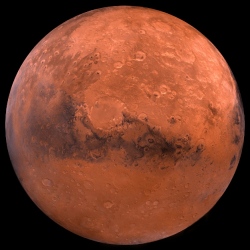
Beagle 2, the failed British mission to Mars in 2003, came "excruciatingly close" to succeeding, a study shows. A new analysis of pictures of the Beagle 2 spacecraft shows that it did not crash-land on the Martian surface. Instead, it indicates that the landing went to plan and at least three of its four solar panels opened successfully.
The analysis also suggests that the probe may even have worked for several months, but was unable to send its data back to Earth. Prof Mark Sims of Leicester University, who commissioned the study, told BBC News that there is an extremely small possibility that Beagle 2 might still be working on the Martian surface.
"It may have worked for hundreds of days depending on how much dust was deposited on the solar panels and whether any dust devils were cleaning the panels – as happened with Nasa’s Mars Exploration Rovers," he said.
"One possibility is that it could still be working today – but it is extremely unlikely and I doubt that it is."
Dr Manish Patel, of the Open University, was among the hundreds of UK scientists who worked on the Beagle 2 mission. He agrees that the new evidence suggests that Beagle 2 took lots of scientific data but was unable to send it back.
"If Beagle 2 went into surface operations mode, it could have continued for some time performing the initial pre-programmed operations, happily taking data and waiting for a response from the orbiters. It turned out to be a very lonely time for the lander at the surface," he said.
Those views are backed by Prof Jan-Peter Muller of the Mullard Space Science Laboratory, which is part of University College London – who has no ties with the Beagle-2 mission.
"Given that (Nasa’s) exploration rover Opportunity is going strong since January 2004 when it was due to last only until March 2004 and that Mars Express is going strong 13 years after orbit insertion when it was due to last only 3 years, the possibility that Beagle 2 could still be collecting data after 13 years is remotely possible."
The British built Beagle 2 Spacecraft was due to land on the Martian surface on Christmas Day in 2003. The mission was charismatically led by the late Prof Colin Pillinger. The spacecraft was capable of collecting soil samples and analysing them for signs of organic molecules associated with life in a miniaturised on-board laboratory.
Disappointingly, no signal was received on Christmas Day. The search for a response from Beagle 2 continued for several months but the spacecraft was never heard from again.
